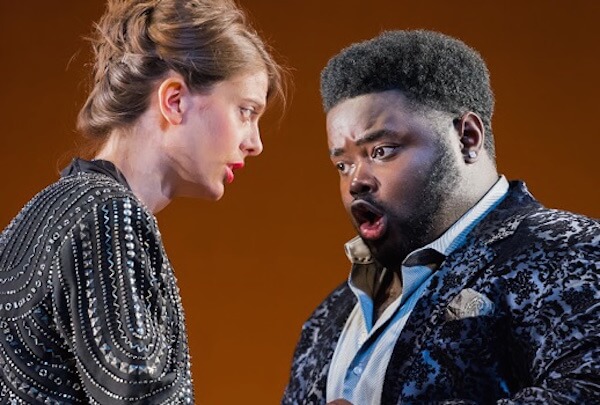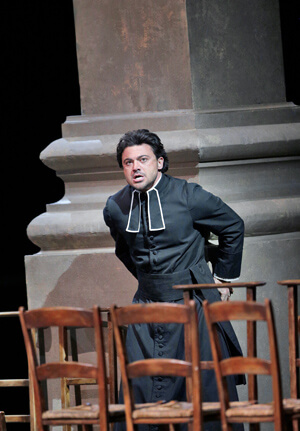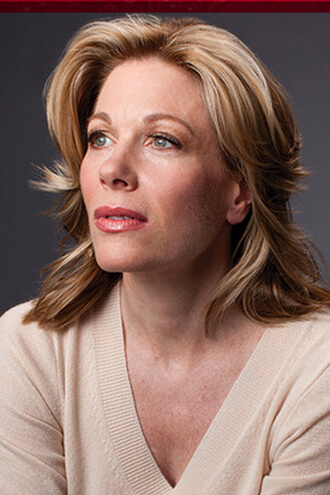All New Yorkers think of their city as the center of the universe and that anything and everything significant that is going on in culture, music, art, whatever, can be found here. Yet in some areas New York is a cultural backwater.
In Europe, the surviving operas of Antonio Vivaldi are being rediscovered and revived at a mind-boggling rate, spurring a cottage industry of new recordings. Yet until this month, to my knowledge, none of his operas have been performed in a staged production in New York City. This past summer, the Glimmerglass Festival presented the American premiere of the surviving two acts of his “Catone in Utica” (“Cato in Utica”) directed by Tazewell Thompson. The conductor on that occasion was Ryan Brown, artistic director of the Washington, DC-based Opera Lafayette. Brown scheduled “Catone in Utica” as part of the company’s 2015-2016 season, bringing a semi-staged concert version to the Gerald Lynch Theater at John Jay College on December 1. This concert stuck to Vivaldi’s original score (unlike the Glimmerglass production that staged Cato’s suicide), including a joyful final chorus that leaves Cato’s gory fate somewhat ambiguous.
Opera Lafayette usually specializes in pre-Romantic French opera — Rameau, Lully, and Gluck, but also Monsigny, Rebel, Philidor, Grétry, and Félicien David. Vivaldi was a change of pace for the company, but one they were well equipped to handle. Brown understands the importance of the recitatives, which were given equal weight balancing the da capo arias. The recitatives drove the work theatrically, with pictorial instrumental commentary and committed emotional expression.
Thriving rediscovery of Vivaldi operas mostly passing us by
The inventive instrumentation of Vivaldi’s “The Four Seasons” was echoed in the constantly surprising orchestral accompaniments. Vivaldi’s largely expository first act is lost. Brown interpolated the overture to Vivaldi’s “L’Olimpiade,” during which characters paraded before us with the surtitles providing their identities and personal agendas. Then we were thrown right into the action in media res.
Thompson provided clear blocking on the small stage, retaining minimal scenic elements from the Glimmerglass staging (such as a throne and a fallen pillar). The singers wore an eclectic mix of costume pieces and modern formal attire.
The vocal standout was the African-American countertenor John Holiday as Julius Caesar (here, a young romantic hero) with a tone of staggering size, richness, and color. Holiday, a recent Juilliard graduate, was rather better at lyrical adagio arias (the aria “Se mai senti spirarti” was ravishing) than martial coloratura allegros. The bravura coloratura showstoppers were left to mezzo Julia Dawson as Emilia, the vengeful widow of Pompey. Initially, Dawson’s slender tone seemed unprepossessing but she tackled the nearly unsingable profusion of 16th notes over a multi-octave range with fiery precision and attack. Countertenor Eric Jurenas as Caesar’s loyal aide Fulvio revealed a dulcet tone with a smooth, fine-grained finish used with refined musicality.
In the title role of the implacable Cato, Thomas Michael Allen is best described as a “Bach tenor” — a dry white-toned tenor with a limited upper extension. However, despite slightly “churchy” Italian, Allen commanded Cato’s declamatory music with firm musicianship and dramatic insight, emerging as an authoritative antagonist.
I was shocked to see Anna Reinhold listed as a mezzo. Model thin and elegant, Reinhold movingly portrayed the anguish of Cato’s conflicted daughter Marzia, but her small colorless tone sounded like a washed out lyric soprano with no high notes. Soprano Marguerite Krull as Marzia’s rejected suitor Arbace occasionally had an edge to her tone but used it for dramatic and musical effect, suggesting the masculine aggression and desperation of the character.
Brown conducted with dramatic insight and highlighted the variety of Vivaldi’s musical inspirations.
Meanwhile, the Metropolitan Opera is presenting revivals of standard repertory with notable role and house debuts to half-empty audiences. In the case of “Die Fledermaus,” this is a shame. After a reportedly shaky opening night, the show coalesced charmingly at the second performance on December 7. Chief credit must be given to James Levine, who seemed in a holiday mood in the pit, relishing one delicious Strauss waltz melody after another.
When this production premiered I felt that the elements of a successful “Fledermaus” were there but hadn’t been properly assembled. This time, Jeremy Sams tightened the show considerably by jettisoning reams of Douglas Carter Beane’s too-clever-by-half dialogue. Sams’ new English lyrics and Beane’s topical gags still include some groaners but they pass by quickly and lightly this time rather than landing with a thud.
The cast was far from perfect but worked well together as an ensemble. Susanna Phillips still struggles with Rosalinde’s high and low notes, but her portrayal has more sex, sass, and self-possession. Toby Spence, a tenor Eisenstein, has never fully recovered vocally from a serious illness, and the baritenor tessitura hits a vocal dry patch which doesn’t project well into the house. Yet Spence’s characterization perfectly balances boyish charm and playboy swagger.
Susan Graham as Prince Orlofsky (sporting a shock of Dmitri Hvorostovsky silver hair) sang with a deliciously plummy, resiny tone and knows the humorous value of understatement. Paulo Szot is a hearty rather than suave Dr. Falke, with a warm personality and voice. Lucy Crowe’s sunny, never vulgar Adele and Alan Opie’s befuddled Frank were improvements on their predecessors. Comic actor Christopher Fitzgerald was droll and inventive in Frosch’s overlong comic spiel at the opening of Act III.
There are much worse holiday entertainments in town, and I highly recommend this one.
The “Fledermaus” benefited from the original director returning and revising the production, which doesn’t happen enough at the Met these days. Michael Mayer’s Las Vegas “Rigoletto” was much more successful when it premiered than the “Fledermaus,” but has benefited from the original director returning to direct the revivals. Peter Gelb has carefully cast each revival with top drawer artists. Even when Simon Keenlyside canceled all his scheduled Rigolettos, the Met was able to get experienced world class Rigolettos like George Gagnidze and Željko LuÄić to replace him.
In the October run, Gagnidze’s sizable, vibrant baritone fearlessly surmounted the high tessitura of the tragic jester’s music. Gagnidze is a dead ringer for Rodney Dangerfield (Mayer’s Rigoletto is a nasty comic) and was better at portraying the extroverted, angry aspects of the character; he needed more heartbreak in Act II.
Olga Peretyatko was a visually lovely, charming Gilda but her soprano has a glint of Slavic metal that gave her sound a soubrettish cast. The coloratura was attacked bluntly in full voice without float or delicacy. In the later acts where Gilda loses her innocence, Peretyatko’s darkish timbre proved dramatically apt.
As the Duke of Mantua, Stephen Costello had the puppyish good looks of an early ‘60s bobby-soxer idol and moved onstage with confident swagger (Mayer is probably to be thanked for this). His blank-eyed stare suggested the moral emptiness behind the Duke’s charming charismatic public persona. Vocally, though, Costello was problematic – the passaggio was way too open, with intonation problems above and below it. Anything high was automatically loud with a bleating tone. Costello’s phrasing was motoric, lacking in seductive grace and nuance.
Katarina Leoson’s Maddalena sounded blowsier than necessary, but Stefan Kocán’s oily lounge lizard Sparafucile had solid low notes and a built-in snarl.
Rising podium star Pablo Heras-Casado led a dashing, firmly controlled performance with unstoppable momentum.
The last performance of the run (December 17) was terrific. Roberto Abbado’s more lyrical reading lacked the Toscanini-like momentum of his predecessor. LuÄić’s jester was more dramatically inflected and engaged than he was at the 2013 production premiere. His burly baritone can hollow out, and sustained high phrases can sag flat. LuÄić eschewed many of the traditional optional high notes, but he sang with a huge range of color and expression and was fascinating to watch.
French tenor Jean-François Borras sang an aristocratic Duke with elegant bel canto phrasing and easy transitions into the high register. He didn’t belt out the arias in a vulgar fashion but nevertheless ended “La donna é mobile” with a ringing high B.
The audience loved recent debutante Nadine Sierra’s Gilda from her first moment onstage and rewarded her with a standing ovation at the end. Totally convincing as a wide-eyed innocent teenager, Sierra has a fine spun, high placed soprano with velvety undertones and delicately precise coloratura. The very forward placement of her slender sound allowed it to travel effortlessly into the huge auditorium. Only 27 years old, this rising soprano has huge potential –– a winningly natural stage presence and a distinctively lovely sound.
Dimitry Ivashchenko proved a find as Sparafucile, with a cleanly produced, firm bass sound (where was he when the Met was casting King René in “Iolanta” last year?) and Nancy Fabiola Herrera repeated her sultry, earthy Maddalena to fine effect. Even the smallest roles were vibrantly characterized, showing Mayer’s commitment to keeping this production just as fresh and detailed as when it premiered.




































